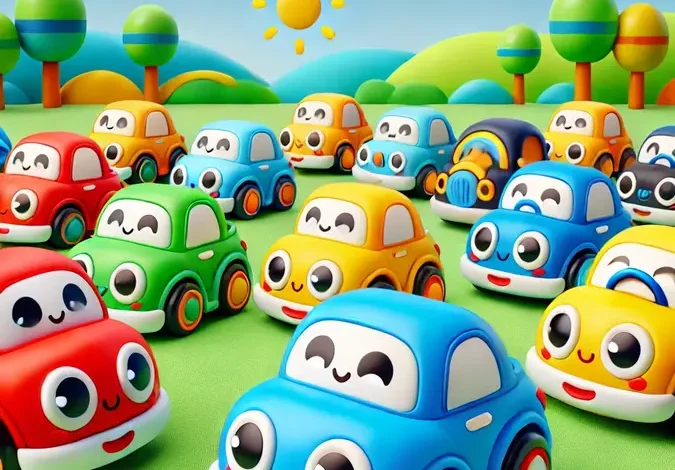The Ultimate Guide to Kids Cars: Choosing, Benefits, and Safety Tips

Introduction
Kids cars have become more than just toys; they are a gateway to independence, coordination, and creativity for children. From electric cars to push-along vehicles, these mini rides offer a world of excitement and learning. As the range of kids cars has grown, so has the need for parents to understand what to look for when choosing the right one. In this article, we’ll explore the world of kids cars, the different types available, the benefits they offer, and the safety considerations that every parent should keep in mind.
Types of Kids Cars: Which One Is Right for Your Child?
Kids cars come in a variety of shapes, sizes, and functionalities. Picking the right type depends on your child’s age, interests, and your budget. Let’s break down the most popular types.
1. Electric Kids Cars
Electric kids cars are battery-powered vehicles that mimic real cars and come in a range of designs, from sports cars to trucks. They are popular among kids who love the idea of driving just like their parents. These cars usually come with working headlights, doors, and even MP3 players for the full “driver” experience.
Electric cars are ideal for children aged 3 and up. They can reach safe speeds (usually 2-5 mph), and many models include parental remote controls, so adults can take over if needed. The downside to electric cars is that they require charging, which means you’ll need a bit of patience if your child drains the battery quickly. Additionally, electric kids cars tend to be more expensive than other types due to their added features and technology.
2. Push Cars and Pedal Cars

Push cars and pedal cars are Kids Cars classics that have stood the test of time. Push cars are often for younger kids, typically toddlers who are not yet ready to handle electric vehicles. They allow parents to push the child along, which can be great for bonding and supervised exploration.
Pedal cars are suitable for kids around 3 years old and up. Unlike electric cars, pedal cars help strengthen a child’s leg muscles and improve coordination. Kids enjoy the physical activity, and parents appreciate the simplicity—no batteries required. Pedal cars also tend to be durable and can handle rougher play, making them great for outdoor use.
3. Ride-On Cars and Scooters
Ride-on cars and scooters are perfect for kids who enjoy both speed and control. These options require children to either sit and scoot themselves or stand and kick, so they’re more physically engaging. Ride-ons are great for developing a sense of balance, spatial awareness, and control.
Scooters, for example, offer different levels of challenge depending on the number of wheels. Two-wheeled scooters are great for older kids who’ve developed more balance, while three- or four-wheeled options provide stability for younger riders. The simplicity of ride-on toys is ideal for parents who want to avoid battery-related maintenance or expensive parts.
Benefits of Kids Cars: Why They’re More Than Just Toys
While kids cars may look like toys on the surface, they offer developmental benefits that contribute to a child’s growth. Here’s a look at why these mini vehicles are beneficial.
1. Developing Motor Skills and Coordination
Kids cars play a major role in helping young children develop their motor skills and coordination. Operating a kids car, whether it’s using the pedals or steering, requires hand-eye coordination and focus. For electric cars, children must learn how to manage the controls, steering, and braking, which can be beneficial for their motor development.
Additionally, pushing or pedaling requires the use of leg muscles, which promotes physical fitness and strength. This type of play encourages children to use their bodies, improving their spatial awareness and overall coordination. These benefits lay the foundation for more advanced physical activities as children grow older.
2. Encouraging Independence and Decision-Making
Kids cars provide children with a sense of independence. When they’re behind the “wheel,” they feel in control, which is a thrilling experience. This autonomy is essential for their emotional development, as it gives them confidence in their abilities. Even simple choices, like deciding where to drive their car or how fast to go, empower them to make decisions on their own.
Decision-making is another key skill that children practice while using kids cars. They learn to navigate around obstacles and assess the best paths to take, which fosters critical thinking and problem-solving. Over time, these small decisions help build self-esteem and encourage children to approach challenges with a positive mindset.
3. Enhancing Imagination and Creativity
Kids cars open up a world of imagination. A child driving a mini police car might pretend to be an officer chasing a “criminal,” while another in a luxury electric car might imagine they’re headed to an important meeting. This imaginative play is essential for cognitive development, as it encourages children to use their creativity.
For many children, kids cars are a way to role-play and explore adult responsibilities. These scenarios allow them to experiment with social roles, which can help them understand the adult world in a safe and playful environment. Whether they’re playing solo or with friends, this imaginative play boosts their social skills and emotional intelligence.
Safety Tips for Kids Cars: Keeping Playtime Safe
As exciting as kids cars are, safety is always the priority. Here are essential tips to keep in mind to ensure your child’s safety while they enjoy their car.
1. Choose Age-Appropriate Models
Choosing a car that matches your child’s age and skill level is crucial. For instance, electric cars are generally better suited for children aged 3 and up, as they require a level of understanding and control. Younger children may benefit more from push cars or ride-ons, which provide a safer introduction to riding.
Always check the manufacturer’s age and weight recommendations, as they’re there to guide you in making the best choice. It’s better to start with a simpler car and upgrade as your child grows, rather than pushing them into a model they may not be ready for.
2. Use Parental Controls and Safety Belts
Most electric kids cars come with parental remote controls, allowing you to guide your child’s car or even stop it if needed. This feature is especially useful if you’re in an area with other vehicles or people around. Additionally, look for models with built-in safety belts. Though kids cars move at slow speeds, a seatbelt can help keep your child secure, particularly if they’re driving on uneven terrain.
Teach your child about safety basics, like buckling up and waiting for permission before driving. This instills an understanding of safety rules that they can apply in other areas of life as well.
3. Ensure Safe and Supervised Play Areas
Kids cars are best suited for open, flat areas where children can drive without encountering too many obstacles. Avoid hilly areas, busy roads, or areas near water unless you’re there to supervise closely. Even in backyards, make sure there’s enough room for them to maneuver without bumping into sharp objects or dangerous surfaces.
If you’re in a public area, like a park, stay close and keep an eye out for other children or pets. Clear communication about safe zones and boundaries will help keep your child’s playtime safe and enjoyable.
Maintaining Kids Cars: Simple Tips for Longevity
Taking care of kids cars ensures they last longer and remain safe for use. Regular maintenance can prevent breakdowns and unexpected issues, allowing your child to enjoy their toy for years to come.
1. Charge Batteries Properly
For electric kids cars, charging is an essential part of upkeep. Make sure to charge the car’s battery fully before use, as partial charges can wear down the battery over time. Follow the manufacturer’s recommendations for charging intervals to avoid overcharging, which can also reduce battery life.
If your child uses their car daily, consider setting a schedule for charging. Avoid storing the car in extreme temperatures, as both heat and cold can affect the battery.
2. Keep It Clean and Free of Debris
Kids cars often attract dirt, especially if they’re used outside. Wipe down the car regularly to prevent dust and grime from clogging parts. Pay special attention to the wheels, which can pick up debris that may hinder smooth operation.
Check any moving parts for signs of wear or rust, and consider a quick wipe-down with a damp cloth after each use to keep the car looking good as new. For pedal cars, ensure the pedals move smoothly and are not obstructed by dirt or debris.
3. Check for Loose Parts Regularly
Kids cars can experience wear and tear over time, especially if they’re used often. Check for loose screws, broken parts, or any components that may need adjustment. If you notice any unusual noises or jerking movements, inspect the car to make sure everything is in working order.
A routine check can prevent small issues from becoming larger, costly problems. Making this a habit will help your child’s car stay in top condition for longer.
Conclusion
Kids cars are more than just fun toys; they’re valuable tools for a child’s development. From fostering independence to building motor skills, they offer a variety of benefits. Whether you’re looking for an electric car, a push car, or a simple ride-on, there’s a kids car out there to fit every child’s needs. Just remember to prioritize safety and maintenance, and you’ll create a fun and enriching experience that your child will remember for years.



